Tag_soil
Type of resources
Available actions
Topics
Keywords
Contact for the resource
Provided by
Years
Formats
Representation types
Update frequencies
status
Scale
Resolution
-
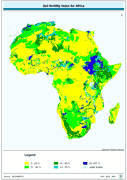
Soil fertility index for Africa derived from the FAO/UNESCO Digital Soil Map of the World interpreted in terms of soil fertility.
-
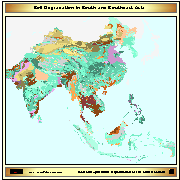
ASSOD (1997) is a follow-up activity of GLASOD. The same methodology was used at a more detailed scale (1:5M) for South and Southeast Asia. The GLASOD methodology was slightly refined. © ISRIC,FAO,UNEP, 1997
-
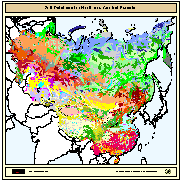
The digital soil map for North and Central Eurasia region (covering China, Taiwan Province of China, Mongolia, CIS and the Baltic States) was prepared by FAO and IIASA in co-operation with: ? the Institute of Soil Science, Academia Sinica (Li Jin, Zhou House in 1978) for China and Taiwan Province of China (scale 1:4 million). ? the Pocveni Institute, V. Stolbovoy and B. Sheremet (1994) for Mongolia (scale 1:2.5 million) The original soil maps from China, Mongolia and CIS_BS have been merged by introducing DCW boundaries between: China-CIS_BS; China-Mongolia; Mongolia-CIS_BS. The original soil map of China includes the Chinese line between India and China, which extends beyond the Indian line, and the South China Sea islands (no soil information is present for the South China Sea islands). Those boundaries do not imply the expression of any opinion whatsoever on the part of FAO concerning the legal or constitutional states of any country, territory, or sea area, or concerning delimitation of frontiers. For further information on related tables, texture etc. please read the readme.rtf and readme.xls documents available for downloading.
-
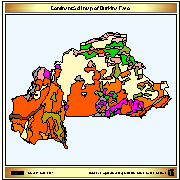
Dominant soil map of Burkina Faso derived from the Digital Soil Map of the World.
-
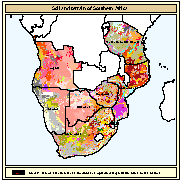
The compilation of a Soil and Terrain digital database for the South-African region forms a part of the ongoing activities of the Food and Agriculture Organisation of the United Nations (FAO) and the International Soil Reference and Information Centre (ISRIC) to update the world's baseline information on natural resources. The updating of world soil resources, using the Soil and Terrain (SOTER) digital database methodology, is part of a global SOTER programme and intended to replace the FAO/Unesco 1:5 million scale Soil Map of the World (1971-1981). The African sheet of this map was published in 1973 and has been compiled on basis of information and data available at that time. It is understandable that a substantial part does not reflect the present state of knowledge of the soils in that region. The national institutes, responsible for the natural resources inventories, have been collecting a wealth of new information on the distribution and occurrence of soils in their region, which has resulted in updating their national soil maps mostly at scale 1:1 million, often applying the Revised Legend (FAO, UNEP, ISRIC, 1988) for the description of the mapping units. The International Union of Soil Science (IUSS) adopted an important change in the classification used for the map by introducing lower levels of subunits of the World Reference Base for Soil Resources (IUSS, FAO, ISRIC, 1998). This, together with the new soil data available at national level, justified such an update of the soil resources for the Southern African region. The compilation of a Soil and Terrain digital database for the South-African region forms a part of the ongoing activities of the Food and Agriculture Organisation of the United Nations (FAO) and the International Soil Reference and Information Centre (ISRIC) to update the world?s baseline information on natural resources. The updating of world soil resources, using the Soil and Terrain (SOTER) digital database methodology, is part of a global SOTER programme and intended to replace the FAO/Unesco 1:5 million scale Soil Map of the World (1971-1981). The African sheet of this map was published in 1973 and has been compiled on basis of information and data available at that time. It is understandable that a substantial part does not reflect the present state of knowledge of the soils in that region. The national institutes, responsible for the natural resources inventories, have been collecting a wealth of new information on the distribution and occurrence of soils in their region, which has resulted in updating their national soil maps mostly at scale 1:1 million, often applying the Revised Legend (FAO, UNEP, ISRIC, 1988) for the description of the mapping units. The International Union of Soil Science (IUSS) adopted an important change in the classification used for the map by introducing lower levels of subunits of the World Reference Base for Soil Resources (IUSS, FAO, ISRIC, 1998). This, together with the new soil data available at national level, justified such an update of the soil resources for the Southern African region.
-

The compilation of a Soil and Terrain digital database for the South-African region forms a part of the ongoing activities of the Food and Agriculture Organisation of the United Nations (FAO) and the International Soil Reference and Information Centre (ISRIC) to update the world?s baseline information on natural resources. The updating of world soil resources, using the Soil and Terrain (SOTER) digital database methodology, is part of a global SOTER programme and intended to replace the FAO/Unesco 1:5 million scale Soil Map of the World (1971-1981). The African sheet of this map was published in 1973 and has been compiled on basis of information and data available at that time. It is understandable that a substantial part does not reflect the present state of knowledge of the soils in that region. The national institutes, responsible for the natural resources inventories, have been collecting a wealth of new information on the distribution and occurrence of soils in their region, which has resulted in updating their national soil maps mostly at scale 1:1 million, often applying the Revised Legend (FAO, UNEP, ISRIC, 1988) for the description of the mapping units. The International Union of Soil Science (IUSS) adopted an important change in the classification used for the map by introducing lower levels of subunits of the World Reference Base for Soil Resources (IUSS, FAO, ISRIC, 1998). This, together with the new soil data available at national level, justified such an update of the soil resources for the Southern African region. The compilation of a Soil and Terrain digital database for the South-African region forms a part of the ongoing activities of the Food and Agriculture Organisation of the United Nations (FAO) and the International Soil Reference and Information Centre (ISRIC) to update the world?s baseline information on natural resources. The updating of world soil resources, using the Soil and Terrain (SOTER) digital database methodology, is part of a global SOTER programme and intended to replace the FAO/Unesco 1:5 million scale Soil Map of the World (1971-1981). The African sheet of this map was published in 1973 and has been compiled on basis of information and data available at that time. It is understandable that a substantial part does not reflect the present state of knowledge of the soils in that region. The national institutes, responsible for the natural resources inventories, have been collecting a wealth of new information on the distribution and occurrence of soils in their region, which has resulted in updating their national soil maps mostly at scale 1:1 million, often applying the Revised Legend (FAO, UNEP, ISRIC, 1988) for the description of the mapping units. The International Union of Soil Science (IUSS) adopted an important change in the classification used for the map by introducing lower levels of subunits of the World Reference Base for Soil Resources (IUSS, FAO, ISRIC, 1998). This, together with the new soil data available at national level, justified such an update of the soil resources for the Southern African region.
-
ISSOIL (Flag for non-soil units). Field indicating if the soil mapping unit is a soil or a non-soil. CODE ISSOIL 0 Non-soil unit 1 Soil
-
Reference depth of the soil unit. Reference soil depth of all soil units are set at 100 cm, except for Rendzinas and Rankers of FAO-74 and Leptosols of FAO-90, where the reference soil depth is set at 30 cm, and for Lithosols of FAO-74 and Lithic Leptosols of FAO-90, where it is set at 10 cm6 . An approximation of actual soil depth can be derived through accounting for relevant depth limiting soil phases, obstacles to roots and occurrence of impermeable layers (the latter two refer to ESDB only).
-

The Soil and Terrain Database Map of East Africa is a computer system for the storage, display, interpretation and analysis of the Soil Map of East Africa at scale 1:1.000.000. The system consists of the soil and terrain database with corresponding soil maps, that are accessed by the programme for visualization in different viewer formats. Various interactive querying and selection tools provide easy access to specific parts of the database for display as thematic map, data browser or data entry form.
-
ROOTS (Obstacle to Roots): Provides the depth class of an obstacle to roots within the STU Code Obstacle to roots (ROO) 0 No information 1 No obstacle to roots between 0 and 80 cm 2 Obstacle to roots between 60 and 80 cm depth 3 Obstacle to roots between 40 and 60 cm depth 4 Obstacle to roots between 20 and 40 cm depth 5 Obstacle to roots between 0 and 80 cm depth 6 Obstacle to roots between 0 and 20 cm depth
 FAO Map Catalog
FAO Map Catalog